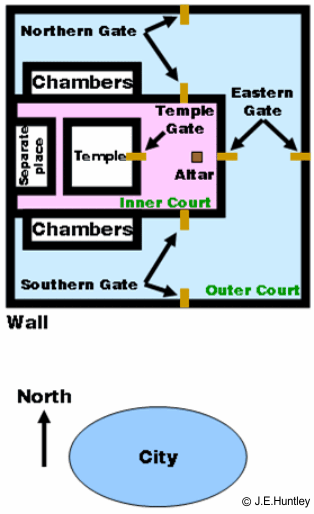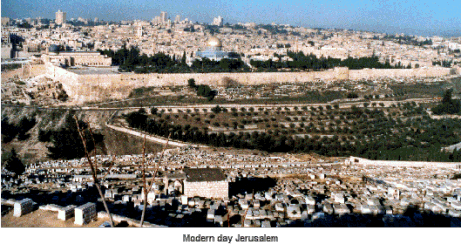Ezekiel: Chapter 43
Setting
Ezekiel 43:1-27 is a continuation of Ezekiel 40:1-49, Ezekiel 41:1-26, and .Ezekiel 42:1-20
| Verses | Topic |
|---|---|
| 1-11 | The return of the Glory of the Lord |
| 12-17 | The law of the house |
| 18-27 | Ordinances of the altar |
In Ezekiel 43:1-5, Ezekiel is still in the outer court, and is now being taken near the eastern gates, that lead outside of the temple area and the other gate that leads into the inner court.  At that time, Ezekiel observed the Glory of the Lord coming from the east. He also heard the Lord's voice, which sounded like the roar of rushing waters. With the Lord's presence, the land was radiant with His glory.
At that time, Ezekiel observed the Glory of the Lord coming from the east. He also heard the Lord's voice, which sounded like the roar of rushing waters. With the Lord's presence, the land was radiant with His glory.
Ezekiel makes the connection between what is revealed to him this time in contrast to the vision he had when God departed from the temple, Ezekiel 11:22-24. In the first vision, Ezekiel observed all of the activity associated with the Lord's departure from the temple. In this vision he observes the brilliance of the Lord's glory on His return to the temple via the eastern gates. At this sight, Ezekiel falls down on his face. The Spirit then lifted Ezekiel up and brought him to the inner court, but not into the temple. From his vantage point, he could see the Lords glory fill the temple, just as the Lord did with the tabernacle, and Solomon’s temple. It is important to point out that many over the centuries have believed and expected that the Lord would return through the walled up eastern gate now in Jerusalem. As indicated in Ezekiel 40:2, the city is now south of the temple area, as shown in the simple schematic to the right, and not surrounding the temple area as in the past. Now, the eastern gates referred to in these passages is in the temple area itself. As will be seen later, these gates will be shut because the Lord passed through them. Only one of the two eastern gates will be open for a special occasion. This is the occasion when one is taken and the other left behind time of Matthew 24:36-42, Daniel 12:12. The saints of God had suffered so much through the seven years of tribulation at the hands of Satan, as well as the AntiChrist and the False Prophet, Revelation 12:17, Revelation 13:5-8, Revelation 13:11-17. God sent His angel in the second half of the tribulation to encourage His saints by announcing the everlasting gospel, Revelation 14:6-7. Those saints who survived through the tribulation were blessed because they were invited to the wedding feast of the Lamb, Revelation 19:9. Those saints who were killed for the Word of God and for their witness were blessed as they were part of the first resurrection. In every case, they will all witness the glory of the Lord filling His millennial temple.

In Ezekiel 43:6-9, Ezekiel hears the Lord speak to him from within the temple. The Lord confirms that this is where His throne is and that He lives among the Israelites forever. From that time forward, His name will never again be defiled by Israel or their kings, nor by their adulteries or by idols. In the past some Israelites would erected their homes and buildings next to the temple, and place worldly things next to Godly things. They did not consider the sanctity of those things dedicated to the Lord, by not showing the separation between God and the World (consider the chambers that only the priests in the line of Zadok could live in the millennial temple). This is why God judged them. Now, during the millennial reign of the Lord, they are to put away all these evil practices.
In Ezekiel 43:10-11, Ezekiel is now instructed by the Lord to describe the temple to the people. If they are ashamed of their sins, Ezekiel is to show them the design of the temple, its physical layout, and its regulations and laws. Ezekiel is to write these down so that the Israelites may be faithful in all things regarding the temple.
In Ezekiel 43:12-17, the whole mountain top on which the Temple is located is to be holy. In these verses, the measurements commence, this time with the altar. The altar is described to be rather large square, with four horns. There will also be stairs leading to the altar, extending from the altar toward the east gate leading into the outer court from the inner court.
In Ezekiel 43:18-27, the regulation for sacrificing burnt offerings and sprinkling blood upon the altar is given. In consecrating the altar they were to:
- On the first day of the consecration of the alter, they are to:
- Offer a one year-old bull as a sin offering to the pries
- The family of Zadok, of the tribe of Levi, were chosen to come near to the Lord
- They are to put the blood on the four horns and the four corners of the upper ledge and all around the rim to purify the alta
- The bull is to be burnt in a designated area in the temple outside the sanctuary, which is the way the Lord instructed Moses, Exodus 29:14, and in several places in Leviticus
- This all pointed to Christ being offered outside of the temple when He was crucified because the offering was a sin offering, Hebrews 13:11-13
- On the second day of the consecration of the altar, they are to:
- Offer a male goat without a blemish for a sin offering
- In Leviticus 1:10, it was either a lamb or a goat, but since the Lamb has already been sacrificed, only a goat is called for
- The altar is to be purified as it was with the bull
- Next they are to offer a young bull and a ram, without blemish
- The priests are to sprinkle salt on the offering, then present them as a burnt offering to the Lord
- For seven days they are to:
- Provide a male goat daily for a sin offering
- Provide a young bull and a ram without blemish
- Make atonement for the altar and cleanse it, which dedicates it
- On the eighth day:
- The priests are to present their burnt offerings and fellowship (or peace) offerings wherein the person making the burnt offering could also partake of the offering on the alter
- Then the Lord will accept the person making the offering
There are many arguments within the Church as to why a sacrificial system during the millennial reign of Christ is necessary since the entire sin issue was settled on the cross completely. As a result of the arguments, some feel that the foregoing verses in this chapter are allegorical. However, there is so much specificity in this passage concerning the dimensions of the temple, and the sacrificial process, that one cannot ignore the possibility of this being the regular practice that the Lord is instituting during His millennial reign. This would by no means diminish or take away the work of Jesus Christ on the cross to atone for the world's sin, but these practices would point back to that point in time, similar to the Old Testament saints' practice of sacrificial worship that pointed forward to the cross.
Two other points need to be made. First, since there will be longevity of life during the millennial reign of the Lord Jesus Christ, Isaiah 65:18-20, and Satan will be bound in the bottomless pit during that time, Revelation 20:1-2, so the concept of death, the horror and penalty of sin will be somewhat removed from the people living in those days. Just as the church has the commemoration of the Lord's supper, Mark 14:22-25, so the millennial saints will have this as their offerings to remember the Lord's work. Second, the need for such a memorial is evident by the final rebellion that will occur by an innumerable number of people in those days who will be seduced by Satan after his release from the bottomless pit, Revelation 20:7-15. When it gets to the point when the rebels surround the holy temple and city of God, that fire from the Lord will descend from heaven, and consume all of them. Thereafter, the second resurrection will occur and all who have not believed and called upon the name of the Lord, will appear before the great white throne judgment, and then they will be thrown into the lake of fire for all future eternity.
